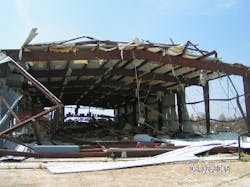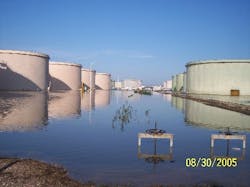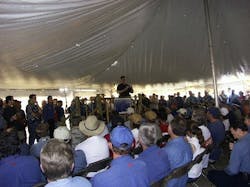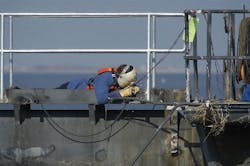Situated on more than 3,000 acres adjacent to the Mississippi Sound on the southeast coast, Chevron’s refinery in Pascagoula, Miss., regularly faces the risk and reality of hurricanes. Last summer, the refinery came face-to-face with one of the costliest and deadliest storms on record – Hurricane Katrina.
The overwhelming majority of stories during and after Katrina focused on what was wrong with preparation or response, or on the extraordinary experiences and outpouring of assistance from millions of people both in and outside the affected region.
Pascagoula Refinery’s story is different. Here, well-rehearsed preparations, solid infrastructure planning and competent personnel worked together, not only to save the refinery from major repercussions, but to help employees, the surrounding community, regional governments and emergency responders, and the rest of the nation ride out the storm and its aftermath.
Indeed, the refinery’s survival and rebound from the wrath of Hurricane Katrina appears routine. The facility’s path to recovery, lessons learned, and sustained commitment to its employees, the local community and the oil-buying public serve as a model for any organization facing emergency conditions. Plant Services is proud to honor Chevron’s Pascagoula Refinery as our 2006 Survivor USA Plant of the Year.
Chevron’s biggest refinery
Chevron’s Pascagoula Refinery began operations in 1963. During the years, it has grown to become the corporation's largest and most complex refinery, and one of the top 10 petroleum refineries in the United States. Pascagoula Refinery processes more than 100 million barrels of crude oil a year with virtually non-stop operation. Before the storm, on a daily basis, it processed 330,000 barrels (13.9 million gallons) of crude oil and produced 5 million gallons of gasoline.
The refinery is strategically located in Mississippi’s Jackson County on the Gulf of Mexico, adjacent to the Port of Pascagoula, two interstate highways, a railroad, and two major oil pipeline systems. Its crude oil arrives by marine tankers, primarily from Central and South America, and is discharged into storage tanks before refining. The five-step refining process includes distillation, treating, cracking, reforming and blending. Finished petroleum products and chemicals are distributed via ship, pipeline, truck and rail. Regional distribution centers supply the products to consumer and industrial customers throughout the South.
Pascagoula Refinery's finished products fuel the nation’s economy. Primary products are gasoline, jet fuel and diesel fuel, as well as fuel oils, liquefied petroleum gas (LPG), aviation gasoline, petroleum coke and sulfur. The refinery also manufactures chemicals used as feedstock in the textile and plastics industries, and to manufacture products including automobile tires, sporting goods, nylon and pharmaceuticals.
The refinery is the county’s largest taxpayer, and in normal operations employs 1,200 people plus 400 to 1,500 contractors. Accordingly, in the event of an emergency, Chevron’s immediate priorities include employee care and safety, community relief and minimizing environmental damage, followed by full restoration of critical operations.
Emergency readiness
The Atlantic hurricane season lasts six months, making hurricane preparedness plans in this region as commonplace as earthquake kits in California. Because so many hurricanes pass through or develop over the Gulf of Mexico, companies up and down the Gulf Coast take disaster planning very seriously. The size, intensity and paths of hurricanes fluctuate, so each storm is carefully and constantly tracked to evaluate its ultimate risk.
The Pascagoula Refinery is no stranger to hurricane-related damage. The plant flooded in 1969 under Hurricane Camille and again in 1998 under Hurricane Georges. The destruction Georges caused was so severe that it took three months to return to normal production levels. Afterward, to help prevent such an occurrence from happening again, a five-mile-long dike was raised around the refinery.
Naturally, emergency preparedness and response are top of mind at the refinery. Chevron carries insurance for both business interruption and property damage. Their process units are routinely monitored to identify vulnerabilities and determine the potential impact. The refinery maintains regular contact with state and local agencies and works with them to conduct large-scale emergency drills.
The plant has 10 medical first responders and 25 nationally certified Emergency Medical Technicians on staff for medical emergencies. An on-site fire department, called the Plant Protection Group, consists of 11 full-time, certified firefighters who conduct regular training for the refinery’s Emergency Response Team (ERT). The ERT includes 80 employee volunteers who undergo 150 hours of specialized training each year to respond effectively to industrial emergency situations.
Furthermore, the refinery has developed multiple emergency response plans. The Incident Command Center (ICC) was established to manage comprehensive responses and maintain communication with all area government agencies. The Public Affairs Team is responsible for providing updates to the media, employees and community.
Hurricane warning
- Thursday, Aug. 25, 2005: Hurricane Katrina crossed over south Florida as a Category 1 storm.
- Friday, Aug. 26, 2005: Hurricane Katrina emerged from Florida into the Gulf of Mexico and tracked toward the Mississippi/Louisiana coast.
- Saturday, Aug. 27, 2005: The hurricane reached Category 3 intensity. Parts of Louisiana were asked to evacuate, and Louisiana was declared a federal state of emergency.
- Sunday, Aug. 28, 2005: Katrina grew to Category 5 with maximum sustained winds of 175 mph, gusting to 215 mph. A federal state of emergency was declared in Mississippi and Alabama. Parts of Mississippi, including Jackson County, began evacuating.
The refinery maintains a detailed hurricane preparation checklist. Any time there is a major storm in the Gulf, the refinery goes on alert. Depending on the track and intensity of the hurricane, decisions are made concerning shutting the refinery down, totally evacuating the facility, and sometimes storing additional supplies of gasoline as a precaution. It’s a rigorous procedure that conforms to each hurricane event as it forms.
“Whenever a hurricane approaches, we have to give ourselves enough time to safely shut down in an orderly manner, making sure no one is injured, while also providing sufficient time for employees to evacuate their homes,” says Steve Renfroe, Pascagoula Refinery manager of public and government affairs for the State of Mississippi.
The checklist covers all aspects of the business, from operations and maintenance to the storerooms, data centers and transportation terminals, including every employee, contractor and guest at the plant.
For Hurricane Katrina, Chevron’s standard operating procedure required a complete lockdown. All systems were shut down and all personnel were evacuated from the Pascagoula Refinery complex. This included its 20 major refining process units, more than 200 storage tanks with 600 million gallons total capacity, four marine terminals with seven berths, a marketing terminal, an LPG truck terminal, several chemical production units, and offices for the Pascagoula Port Operations Center.
Even the designated Ride Out Crew didn’t ride out this storm at the plant. They would be the last to leave and the first to return. After securing the refinery, the crew stayed about 25 miles inland at the East Central Community Center in Hurley for the duration of the storm.
Katrina arrives
- Monday morning, Aug. 29, 2005: Hurricane Katrina made landfall as a strong Category 3 near Buras, La., with sustained winds of 125 mph. President Bush declared a major disaster for Louisiana, Mississippi and Alabama.
- Monday afternoon, Aug. 29, 2005: The storm slowly meandered northward, the wind changed direction, and Katrina weakened into a tropical storm.
Katrina was an intense and slow-moving hurricane of tremendous size that caused unprecedented devastation along the central Gulf Coast. Wind gusts higher than 140 mph were recorded at landfall in southeastern Louisiana. Hurricane-force winds extended outward 120 miles from the center, and Katrina’s forward speed was just 15 mph. The storm surge along the central Mississippi Coast was reportedly 28 ft., and rainfall accumulations exceeded 8 to 10 in.
The aftermath
Beginning on August 29, 2005 as soon as conditions were deemed safe for aircraft operation, corporate jets flew low, slow reconnaissance flights over Chevron’s offshore rigs and onshore facilities to carry out initial damage assessments. The Ride Out Crew returned on August 30, 2005 immediately after government officials declared the area safe, to evaluate and photograph the flooding and wind damage endured by the complex.
The Pascagoula community was particularly hard-hit. Muddy sediment covered walls, floors and streets. Flood waters had carried possessions into the street. Homes collapsed on their foundations and entire neighborhoods were reduced to rubble.
Pascagoula Refinery’s perimeter dike protected it from catastrophic damage. This time, wind was the primary cause of destruction to the complex. It peeled back the sheet metal on roofs and cooling towers, and ripped portions of the outer wall and insulation from a refinery tank. Torn insulation from LPG spheres landed along the tank field road. A warehouse near the refinery wharf sustained substantial damage – just the shell of the steel-framed building remained standing in the wake of the storm (Figure 1).
Figure 1. High winds peeled sheet metal off roofs and cooling towers, tore off insulation and heavily damaged this warehouse near the refinery wharf.
Two minor breaches occurred on the west dike, and parts of the refinery sustained flooding (Figure 2). It was relatively minimal, considering Pascagoula was reported to be among the most severely flooded areas. Floodwaters caused some LPG rail cars to float off the tracks, and the refinery docks sustained fairly significant damage. Additionally, about 40 gallons of jet fuel and 10 gallons of gasoline escaped the refinery during the storm.
Figure 2. The refinery sustained relatively minimal flooding thanks to a five-mile-long dike installed after Hurricane Georges in 1998.
Recovery begins
After the hurricane, the entire Jackson County population sought a rapid return to normalcy, and recovery efforts began in earnest. Pascagoula Refinery concentrated its immediate efforts on getting employees back on their feet, establishing an emergency fuel supply, repairing the infrastructure, restarting normal production, and aiding the community. These objectives were closely interrelated and many of the activities occurred concurrently.
Employee assistance
Some employees returned to the refinery the day after the hurricane, and others gradually followed. Chevron placed newspaper advertisements and used Internet and radio communications asking employees to call an 800 number to report their situation. In some cases, refinery personnel visited employees at their homes.
By the end of the first week, all refinery employees were accounted for. Not a single employee was lost in the storm, however, many suffered personal losses, and about 300 lost or experienced significant damage to their homes – including the general manager.
Because of the severe destruction of housing in the community, a tent city, dubbed Camp Chevron, was set up by September 12, 2005 within a few miles of the refinery. The improvised, temporary housing for displaced employees and their families wasn’t preplanned. Chevron ordered the equipment after the hurricane, and suppliers from around the globe, such as Compass Group/ESS, were quick to respond.
Chevron provided the 500,000-sq.ft. camp that held as many as 1,500 people for free. The large, white canvas dormitories (Figure 3) and family chalets had electricity and air conditioning, sewage treatment, satellite communications, medical services, bedding, laundry, toiletries, transportation and three meals per day served in the Courtyard. A children’s play area included board games, toys and a big-screen television.
Figure 3. Camp Chevron housed as many as 1,500 people in canvas dormitories and family chalets with electricity and air conditioning, sewage treatment, satellite communications, medical services, bedding, laundry, toiletries, transportation and three meals per day.
Two “Katrina Fairs” were hosted to inform employees of relief services and assistance available after the hurricane. Everyone met under a giant tent erected in the main employee parking lot (Figure 4). The refinery’s Health Clinic handed out first aid kits at the fair and offered free tetanus shots to Chevron employees. The company’s Employee Assistance Program was expanded to provide support and counseling services to employees and their families.
Figure 4. Roland Kell, Chevron Pascagoula Refinery general manager, addresses employees at one of two “Katrina Fair” information-sharing meetings. Employees also received first-aid kits and tetanus shots.
Able employees rallied to support their peers. Chevron collected clothing donations, which were sorted according to size by volunteers and donated to fellow employees. Non-perishable foods, water and cleaning supply donations were organized into family packs in the Procurement parking lot and distributed to personnel in need. An intranet bulletin-board system was established to facilitate employee offers to help.
The Chevron Home Recovery Team helped fellow Chevron employees clean out their homes, strip wet sheetrock and assist with reconstruction. A Humanitarian Relief Fund was established to channel employee contributions to Chevron families affected by Hurricane Katrina and also Hurricane Rita, which struck three weeks later. Chevron matched these contributions on a one-to-one basis through November 30, 2005.
Infrastructure restoration
There was no electrical power, running water or phone service following the storm, and all were needed to restore refinery operations. Chevron lent financial support and expertise to expedite the restoration.
“It was amazingly apparent how interdependent the area’s systems are,” says Renfroe. “All 195,000 Mississippi Power customers were without power following the hurricane, including the refinery. We supplied fuel to the power company to help them get the electricity back on.”
Without the support of Chevron, the work involved would have taken an additional two or three weeks, says Anthony Topazi, CEO of Mississippi Power. Limited supplies were available to the refinery on September 5, 2005 and full electric power followed by September 19, 2005.
Water service was another critical need. Chevron helped restore the Moss Point and Pascagoula municipal water systems by providing technical assistance, supplying portable generators to power wells, and replacing or repairing pump motors. Industrial water service was restored to the refinery the week of September 12, 2005.
Marine access was required to receive fuel and oil shipments, so refinery management worked with the U.S. Coast Guard and Navy regarding plans to reopen the Port of Pascagoula. Daily briefings were organized at the Jackson County Port Authority and conducted in its parking lot until electricity was restored. With Chevron’s help, the Port of Pascagoula reopened for incoming ships within 10 days.
Emergency fuel supply
At least seven refineries on the Gulf Coast were disrupted by the hurricane and the nation’s fuel supply became a huge issue. For the first three to four days following Hurricane Katrina, there was barely any fuel supply locally, and regions across the southeast and into the northeast were in jeopardy. Pascagoula had 1 million barrels (42 million gallons) of gasoline on hand in its tanks, which it began shipping within two weeks.
The refinery supplied much of its on-hand fuel to emergency response organizations. First responders, the Red Cross, fire district officials, law enforcement agencies, hospitals and other critical services received priority shipments. Additional company-operated delivery trucks were sourced from Florida and California to support the efforts.
The facility was temporarily transformed into a ‘virtual refinery’ to meet the greater supply needs until it could be restarted. More than 70 million gallons of gasoline were imported, but the gasoline and diesel fuel to be imported didn’t fully meet certain U.S. environmental standards. The variations were insignificant as far as U.S. consumers were concerned.
The refinery asked for, and on August 31st received, waivers from the Environmental Protection Agency (EPA) to help mitigate some of the disruption in fuel supplies.
The imports were directed throughout the southeast and to cities as far away as New York. By the time normal production resumed, the refinery had distributed 2.75 million barrels (115 million gallons) of gasoline locally and through pipelines throughout the southeast and northeast.
“We didn’t make much money on the imports from Europe and other regions, but it was the right thing to do with fuel in such short supply,” says Renfroe.
Refinery repairs
The day after the hurricane, employees began to evaluate the storm’s impact, commence repairs, and ramp up production operations. Initial staff meetings were conducted outdoors for lack of HVAC and electrical power in the office buildings. Engineers and equipment suppliers met in the lobby of the Administration Building. Refinery leadership attended daily meetings in a conference room that soon became the designated “Central Command Center.”
Employees and contractors worked quickly toward the safe and incident-free resumption of operations. Sandbags were used to temporarily fill the breached sections in the dike until they were repaired the week of September 5, 2005. Floodwaters were pumped out after electricity was restored. Wet items were disposed of quickly to prevent mold growth.
Repairs to the Marketing Terminal were essential to resume the flow of fuel to the community, and generators were installed to power the terminal until electricity was restored. Additionally, work to restore the refinery’s Marine Terminal began almost immediately after the storm (Figure 5). A refined product berth was repaired quickly, and damaged crude oil berths followed. “Our docks are the lifeblood of this refinery,” says Chevron Shipping’s Howard Jenkins.
Figure 5. Work to repair the marine terminal began almost immediately so imported gasoline could be received and distributed throughout the stricken region and as far away as New York.
Specifically trained emergency response teams worked to contain and clean up the spill areas under plans approved by federal and state environmental agencies. The EPA analyzed surface and sediment samples as part of a hazardous site investigation and, based on the sampling results, concluded the site wasn’t affected by Hurricane Katrina.
Every day, Chevron employees, contractors, and some new hires staffed a fuel line for critical local services. By the end of the first week, Chevron had reopened about 30 of its 37 service stations across the Mississippi coast.
By October 5, 2005, the refinery successfully and safely initiated the startup procedures for the refinery. Just six weeks after the storm’s landfall, the refinery returned to normal production, injury free – a great improvement over the three months required to ramp up following Hurricane Georges.
Community response
The refinery played an integral role at the daily Jackson County Emergency Operations Center (EOC) meeting in Pascagoula, sharing news about the refinery’s efforts to assist the community.
Chevron distributed free ice and water from the Pascagoula Wal-Mart parking lot, and employees loaded trucks with food to be distributed to the needy. The corporation pledged an initial $5 million to Hurricane Katrina relief efforts, contributed $1 million to local aid organizations, and generously donated essential supplies.
The refinery initiated the Chevron Daycare Restoration Project to help rebuild or restore 40 childcare centers in Jackson County and neighboring communities, many of which were flooded by the hurricane.
Refinery employees also made their mark in more personal ways. Chevron’s Darin Matthews, whose own home was demolished, rescued more than 75 people from rooftops in Pascagoula on August 29, 2005. He and his small skiff shuttled people to shelter at a local fire station.
One year later
Thanks in large part to the dike erected after Hurricane Georges, the damage caused by Hurricane Katrina was relatively minimal, and Pascagoula Refinery’s recovery was much quicker than it might otherwise have been. Not only did it resume normal production within six weeks, but its $150 million upgrade to increase gasoline production by 500,000 gallons per day that began pre-Katrina is on track to be completed this winter as scheduled.
Chevron learned new lessons from the Hurricane Katrina experience and enacted changes accordingly. For example, some refinery procedures were modified, Chevron service stations were provided with their own portable electric power generators, and a new mandatory communication plan was implemented in time for Hurricane Rita that required employees to notify the company of their whereabouts and safety.
Because some employees are still living in FEMA trailers, which are particularly vulnerable to wind storms, evacuations must now commence sooner. The refinery altered hurricane response plans to accommodate accelerated community evacuation orders.
By Thanksgiving 2005, Camp Chevron was dismantled. The company is still evaluating whether to add the camp as a fixture to its emergency response plan, or accomplish temporary housing needs in another manner.
Ultimately, although the Pascagoula Refinery personnel hope they won’t be hit by a hurricane of such magnitude again, they are better prepared to get the refinery and service stations back in operation in a timely fashion.
“I am very, very pleased with the response of Chevron – pleased to work for company that demonstrates so much compassion, not only to its employees but also to the community,” Renfroe says. “The challenges faced by our general manager, Roland Kell, were unprecedented, and he remained courageous, doing what needed to be done not only for the refinery but for our community.”
Timeline
- By August 28, 2005: Shut-down, lock-up and full evacuation
- A.M., August 29,, 2005: Hurricane Katrina makes landfall
- P.M., August 29, 2005: Reconnaissance flights and aerial damage assessments
- August 30, 2005: Ride Out Crew conducts on-ground inspections, first to return commence repairs
- August 31, 2005: Received EPA fuel specification waivers for imports
- September 1, 2005: Chevron announces plans to erect tent city for employees
- September 3, 2005: Multimedia employee outreach and toll-free number established
- September 4, 2005: Katrina Fairs communicated employee assistance, dike breaches were sandbagged, all employees accounted for
- September 5, 2005: Limited electrical power available
- September 6, 2005: Generators power the marketing terminal, on-hand gasoline and diesel provided for emergency services and area service stations, 30 service stations reopened
- September 8, 2005: Port of Pascagoula reopened
- September 11, 2005: Begin shipping on-hand gasoline, dike repairs completed
- September 12, 2005: Camp Chevron opened, industrial water service restored
- September 16, 2005: First fuel import arrived from a European supplier
- September 19, 2005: Full electrical power restored, refined products being transported for delivery in southeastern states
- October 5, 2005: Initiated restart of production operations
- November 24, 2005: Camp Chevron closed





